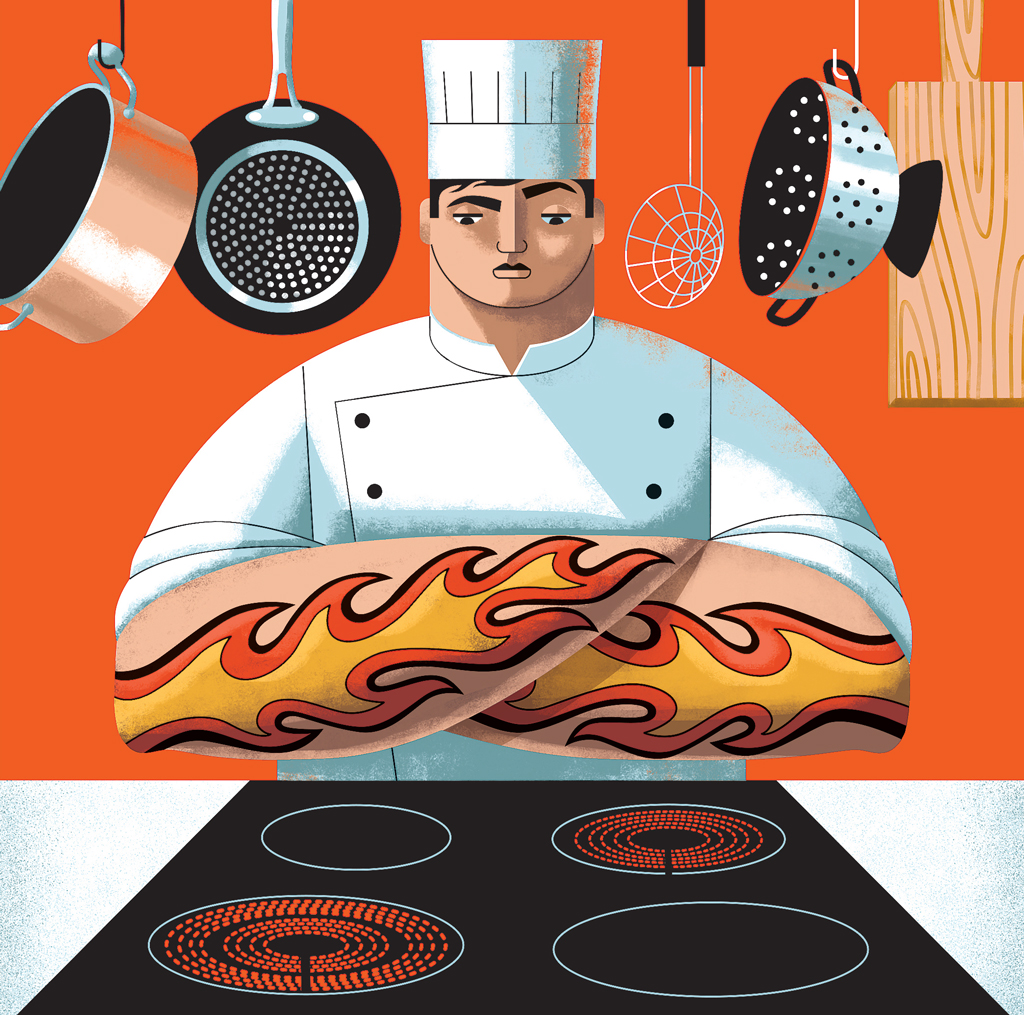
Picture a chunky gas-fired stovetop. Twist a knob, and whoosh—a potent ring of fire licks at a metal grate. Now think of an induction range: a glass flattop etched with pot-sized circles. Push a button, and the reaction is silent and invisible. As a committed home cook who toiled on the fiery line of a Texas steakhouse through high school and college, I see a gas range and something stirs in me; it makes me want to get busy subjecting raw ingredients to the transformations of fire. An induction stovetop? It leaves me cold.
Here’s the thing, though: According to a strand of environmental thinking that’s gaining force, gas cooking may be as much of a mindless indulgence as a Hummer. Last week, the city council in Berkeley, California, took a big step to making it obsolete. The city became the state’s first to ban natural gas hookups for new buildings, both residential and commercial. The rule means that most newly built homes, restaurants, and commissary kitchens in the city will have to rely on electricity for cooking.
The People’s Republic of Berkeley, population 120,000, is on the vanguard here, but it’s not alone. LA Mayor Eric Garcetti recently released a plan to convert all of the city’s buildings to carbon-neutral technology by 2050, which could require all home and commercial cooking appliances to go electric, the Los Angeles Times reported. About 60 other California cities are considering “building code measures to promote electric appliances as a way to reduce greenhouse gas emissions,” reports Inside Climate News. Meanwhile, last week, New York Gov. Andrew Cuomo signed into law an ambitious climate plan that could phase out gas hookups by 2050.
My beloved gas stove isn’t on the chopping block because it guzzles fossil fuel. In the average home hooked up to natural gas service, the furnace and the water heater account for 96 percent of the BTUs consumed, according to the US Energy Information Administration. Cooking burns a paltry 3 percent. But according to the increasingly resonant “electrify everything” school of thought, if we’re going to get serious about slashing carbon emissions, we’ll need to “get as much of our energy consumption as possible hooked up to the power grid,” one of its chief proselytizers, Vox’s David Roberts, puts it. Power grids are getting greener—transitioning from less reliance on fossil fuels to more reliance on renewable energy sources like wind and solar. As power grids take on more wind and solar, they, along with the devices they power, emit less carbon. Gas-powered furnaces, stovetops, and water heaters, by contrast, just chug along, burning gas.
Few people will push back against fully electrifying their homes or restaurants because they cling to their gas furnaces: People want a toasty home in the winter, but they don’t care much how it gets that way. It’s the stovetop that generates deep attachments—especially for chefs.
“Flames are at the heart of what makes cooking visceral and fun,” said Andrea Reusing, chef-owner of Lantern in Chapel Hill, North Carolina, and the restaurant at the Durham Hotel in Durham. She’s “attached to open flame in an emotional, almost biological way,” she added.
“For me, cooking is about emotion, it’s about soul, it’s about the basic elements: fire, water, and air,” said Bruce Sherman, long-time chef-owner of the Chicago farm-to-table temple North Pond. “You extract one of those, what’s left?” Sherman said he’d likely exit the restaurant business if regulations forced him to cut off his gas line. He says he wants to do his bit to slow down climate change—”how about not buying products from feedlots?”—but “there are certain things I’d rather not give up.”
For a long time, the only alternative to this open flame style of cooking was a conventional electric range, whose coils take a while to heat up and cool down, to the frustration of cooks. Induction ranges have been available for decades, but have been slow to take off in the United States. The technology heats a pan up faster even than a gas flame, and can be tempered or shut off just as instantly. It uses a magnetic field to heat up the pan, so the pan itself becomes the heat element—meaning no wasted heat to turn a kitchen into an inferno. Induction ranges are thus more efficient than their gas rivals, requiring about 25 percent less energy to boil an equivalent amount of water.
And induction won’t release the nasty air-borne compounds that come along with gas ranges. Their exhaust contains nitrogen dioxide, carbon monoxide, and formaldehyde and can reach unhealthy levels without a good vent running.
Induction range-tops, however, are more expensive. At Home Depot, a gas range and oven set starts at around $550, while a similar induction set is at least $1,000. At the mid range, a Bosch five-burner gas range goes for around $2,400, while a comparable induction model goes for $3,000. According to Bruce Nilles, managing director of the Rocky Mountain Institute—who co-authored a recent New York Times op-ed making the case for electrifying everything in the home—US prices for induction ranges are about twice those of the United Kingdom, where the technology is much more popular. If ordinances like Berkeley’s take hold, prices will likely plunge to UK levels, he wrote.
Karen Leibowitz, co-owner of San Francisco’s Mission Chinese Food, found induction ranges to be cost prohibitive when she was launching the now-closed restaurant The Perennial, a kind of valentine to sustainable farming. “In the end, we went with gas ranges and directed most of our baking/roasting to the electric-powered oven.” Berkeley’s push against gas is a “legitimate decision,” she said, but it will certainly roil chefs, who “just like cooking with gas.” Ultimately, “I suspect we’ll see a shift to induction, but it would be worthwhile for cities and utilities to offer programs to ease the transition, like subsidies to make induction equipment more affordable and trainings.”
Dan Barber, chef-owner of New York’s Blue Hill restaurants and a sustainable-farming activist, said every station in his kitchens has an induction top for delicate tasks, alongside gas ranges. He has no plans to phase out gas in his kitchens, but if he were forced to by environmental regulations, he said he would probably embrace it. And if he ever builds out a new restaurant kitchen, he would voluntarily go without gas, focusing instead on heating with induction and wood.
When he was coming up as a cook in the 1990s, restaurant kitchens still ran on the classic French model: a “furious, hot, tension-filled world—both in personality [of the cooks] and also in energy—full of heat and metal and stress.” Gas fire played a central role in creating that atmosphere.
Now Barber sees a movement afoot to create a “quieter, less stressful, more contemplative environment in kitchens.” A new generation of chefs have come to see that as the future of cooking professionally and also producing better food. By removing excess heat and adding precision, induction fits into this trend of gentler cooking, he said. The restaurant industry’s embrace of induction for delicate tasks like dessert has already “pushed the technology to become much more modern and advanced.”
Sherman also said he has adopted induction in his restaurant as a supplement to gas, particularly in the pastry station—he appreciates the precision for delicate tasks like melting chocolate and making custards. The roof bar at Reusing’s hotel restaurant uses a small induction unit that she says “works well for soup and even a paella,” even if “it’s annoyingly digital and beeps all the time like it’s angry at us if the pan is too small or too big.”
Barber added that phasing out gas needn’t mean banishing fire from the kitchen altogether. High-end cuisine has “sort of bifurcated between much more gentle cooking and super-hot charcoal-fired and wood-fired cooking.” A lot of chefs are using wood fire to cook pizzas, vegetables, meat, and fish, and using induction to gently cook sauces and other delicate dishes, he said. The high-BTU monster gas range is emerging as “kind of in a dead zone” between these two poles.
I realized that I’ve already been going electric with many cooking tasks without thinking much about it. Several years ago, I stopped boiling water for coffee in a stove-top kettle and switched to a much faster electric one. For long-cooking dishes and even pasta, I have embraced the multi-purpose, highly popular InstantPot, mostly for its pressure-cooking powers. Cooking a pot of beans in an insulated, electric-powered vessel generates a hell of a lot less kitchen heat than putting it on the range for hours—a welcome advantage in the central Texas summer hellscape. Do I really miss that controlled blue flame when the InstantPot’s in action? Also, my range’s pale fire is a sad imitation of what happens in my grill when I cook outside. Maybe, like the chefs who are embracing wood-fired cookery, that’s where I should go to satisfy my primal yearning to unleash flames on food.
Then there’s the fact that if induction technology does take over, it will be only the most recent innovation to completely transform modern cookery. In the early 20th century, wood and coal powered kitchens. The restaurant historian Jan Whitaker recounts a 1903 New York Times article, describing a coal-powered restaurant kitchen:
The reporter visited a large hotel with a battery of over 20 stoves lined up in a row. The heat was overpowering and it took four or five “firemen” to stoke the stoves so that the heat never flagged. The fires needed to be rebuilt about three times a day and two of the stoves were kept going at all times in case the kitchen received an order. Of course kitchens became dirty and quantities of ashes had to be hauled out.
Universal gas distribution—driven by the desire for street lighting—existed by then, and manufacturers had began to promote gas stoves to replace coal ones. “Whatever the shortcomings of coal, it would appear that most chefs preferred it, especially when grilling meat,” Whitaker reports. “Only a few chefs interviewed in the [New York Times] story spoke up for gas.” It wasn’t until the end of World War II that gas became the standard fuel for restaurant ranges. Cuisine endured the demise of coal as cooking fuel. I suspect it will survive without natural gas, too.


















